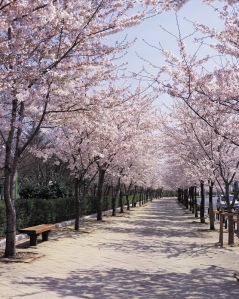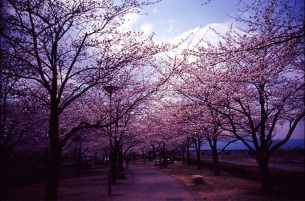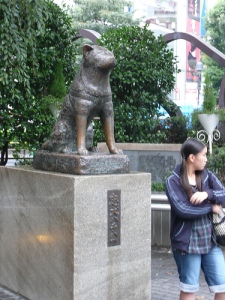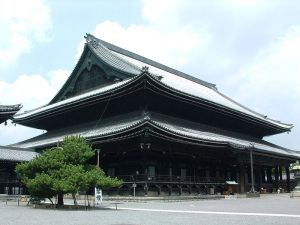Posts tagged ‘Hachiko ‘
Japanese Culture and Tourism.
I’m talking about the Japanese culture and tourism now, which will include both what the Americans consider as real Japanese traits and the real deal.
Sakura (Cherry Blossoms, or Blossoming Cherries)
Many Americans are obsessed with the idea that this is, apparently, what Japan is. A bunch of flowery paths. But while many places have cherry blossoms, they usually only start blooming when it is warm and mild-weathered. This means, usually between February and May. Cherry blossoms are apart of Japanese beauty, and many of the Japanese do go out to see them. In both anime and manga, cherry blossoms are usually introduced in at least one scene.
The word sakura can be misinterpreted as well. In English, the word is equivalent to the Japanese flowering cherry. However, the tree has no relation to sakuranbo, cherry fruits.
In Sand Chronicles, there is also a scene where a cherry blossom blossoms out of season in Tokyo. Ann and Fuji sit under the tree late at night and talk well into the night.
My opinion of it is that it is one of Japan’s key elements.
Parting shot:
Up next, Shibuya’s Hachikou
The Hachikou statue is located in Shibuya, a district in Tokyo, Japan. This statue is a popular meeting place (as you can see to your left) and many people meet friends, boyfriends, business associates, etc. by the statue. But do you know who Hachi himself is? Well, let’s get into detail about that.
Hachikou was a dog born on November 10, 1923 in the Odate, Akita Prefecture. In 1924, his owner Hidesamurō Ueno brought him to Tokyo. Hachikou saw him off from the front door and greeted him at the end of the day at Shibuya Station. When Ueno died in May 1925, Hachikou continued to go to and wait for his master everyday at the station until his death ten years later. He died of heartworm.
Many realized this dog’s loyalty and cherished the dog. Two statues stand for this dog, one in Shibuya and one in Hachikou’s hometown. For Hachi’s loyalty, he received two movies and several books and games.
Detailed picture:
Japanese Shrines and Temples
 Up above is a popular Shinto shrine, dedicated to the goddess Amaterasu Ōmikami. This shrine is located in the Ise city of Mie Prefecture, Japan. Amaterasu Ōmikami is apart of the Shinto religion, a religion which is native to the Japanese. Shinto involves worshiping different gods and goddesses. Quoted from the Shinto Wikipedia article:
Up above is a popular Shinto shrine, dedicated to the goddess Amaterasu Ōmikami. This shrine is located in the Ise city of Mie Prefecture, Japan. Amaterasu Ōmikami is apart of the Shinto religion, a religion which is native to the Japanese. Shinto involves worshiping different gods and goddesses. Quoted from the Shinto Wikipedia article:
“With the introduction of Buddhism and its rapid adoption by the court, it was necessary to explain the apparent differences between native Japanese beliefs and Buddhist teachings. Indeed, Shinto did not have a name until it became necessary to distinguish it from Buddhism. One explanation saw the kami as supernatural beings still caught in the cycle of birth and rebirth (reincarnation). The kami are born, live, die, and are reborn like all other beings in the karmic cycle. However, the kami played a special role in protecting Buddhism and allowing its teachings of compassion to flourish. This explanation was later challenged by Kūkai (空海, 774–835), who saw the kami as different embodiments of the Buddhas themselves. For example, he famously linked Amaterasu (the sun goddess and ancestor of the Imperial family) with Dainichi Nyorai, a central manifestation of the Buddhists, whose name means literally “Great Sun Buddha.” In his view, the kami were just Buddhas by another name.”
This is the honden (main hall) of Higashi Hongan-ji in Kyoto. Buddhism is another prominent religion in Japan, but is not a Japanese native religion. Quoted from the Buddhism in Japan article on Wikipedia:
“The arrival of Buddhism in Japan is ultimately a consequence of the first contacts between China and Central Asia which occurred with the opening of the Silk Road in the 2nd BCE, following the travels of Zhang Qian between 138 and 126 BCE, which culminated with the official introduction of Buddhism in China in 67 CE. Historians generally agree that by the middle of the 1st century, the religion had penetrated to areas north of the Huai River. Buddhism was introduced to Korea by China, and Korea introduced Buddhism to Japan around the 5th century CE.”
Buddhism is based off the teachings of India’s Buddha Shakyamuni. Also quoted from the same article:
“All traditions recognize the Buddha as an enlightened teacher who shared his insights in order to help sentient beings end their suffering (see The Four Noble Truths) in accordance with the laws of Karma by realizing the true nature of phenomena and thereby escaping the cycle of involuntary rebirths known to Buddhists as Samsara. Among the methods Buddhist sects apply towards that goal are ethical conduct, altruistic behaviour, renunciation of wordly matters, the training of one´s mind through learning and meditation, devotional practices and the invocation of holy beings to seek their help in achieving Enlightenment. Followers of the Buddhist path take refuge in The Three Jewels: Buddha (The Enlightened or Awakened One), Dharma (The Teaching), and Sangha (The Community).”
Candy Revolutions
Pocky is… one of Japan’s most famous candies, and is often seen in anime and manga. In fact, it proving to be so popular, you can actually find it on America’s shelves. I have tried it myself, and I have to say – I never leave an FYE store without purchasing it.
Pocky was first sold in 1966 and was an instant hit among teens, bringing in thirty billion yen in just its first two years. The candy is marketed in many countries and continents, including Europe, America, Australia, and China.
It comes in a variety of flavors, the most popular being chocolate, strawberry, and almond. However, there are also seasonal flavors of honey for spring and kiwifruit mango for summer. Nagano’s grape, Hokkaidou’s yuubari melon, Kyuushuu’s tangerine/giant mikan, Kyoto’s powdered tea azuki bean, and Kobe’s Kobe wine are all regional flavors. There are many more flavors, but to save space, I’ll let them slide.
It is pronounced poh-kee and does not rhyme with ‘rocky.’ The romaji spelling is Pokki.
Now that I’ve shared some more detailed information about Japan, it’s time to head out for the night. Hope you enjoyed this one and learned something new, I’m out.
Add a comment Wednesday, August 20, 2008







